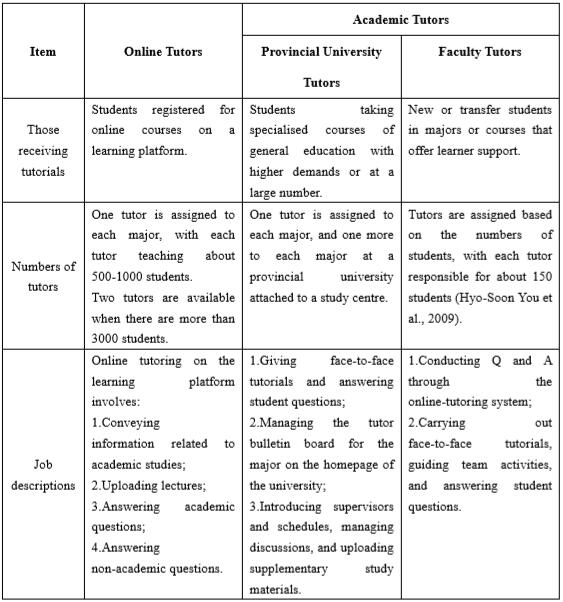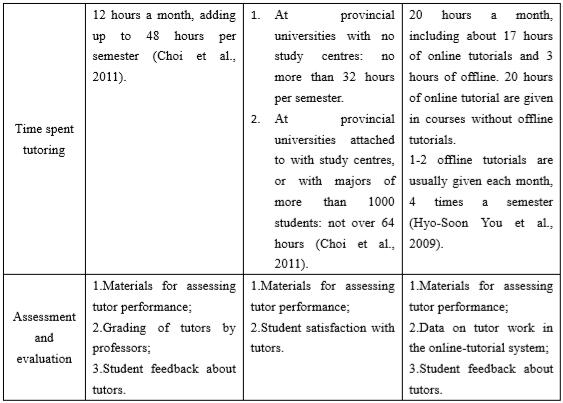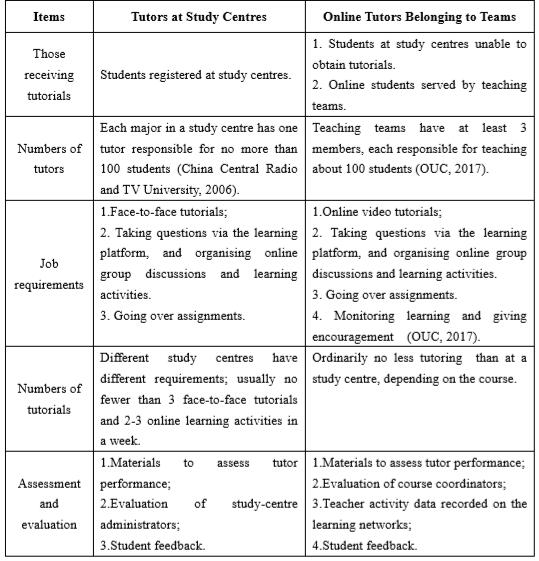Learner Support at Korea National Open University and the Open University of China: a Comparison
Sun Hongfei1, Ji Ruifang2
Abstract: Learner support involves guidance for autonomous learning provided by distance-education colleges and universities, and plays a significant role in the success of distance learners. This paper compares the experiences and practices of Korea National Open University (KNOU) and the Open University of China (OUC) in terms of learner support, including tutorials, counselling, financial assistance, student mutual aid, and student organisations and activities. It analyses the similarities and differences of the various kinds of learner support offered at the two universities. The research shows that the two universities have a lot in common in terms of the contents and overall forms of service, but also that there are significant differences in their specific practices. Suggestions are finally made for changes in learner support at colleges and universities providing distance education in China based on the analysis provided.
Keywords:Korea National Open University; learner support; tutoring; student counselling; student mutual aid
Learner support can improve the quality and effectiveness of distance education, and is an important element of successful learning. With more and more attention being paid to the quality of degree continuing education, distance-education colleges and universities have made many reforms to teaching and to learner support. The OUC has made changes to online teaching, teacher management, and student-affairs management in an effort to provide better learner support and to improve the quality of both teaching and services.
KNOU was founded in 1972. It was the first distance-education university in Korea, and is the only national open university there now, offering degree education at the undergraduate and postgraduate levels, and comprising 13 provincial schools and 35 learning centers nationwide. It employs about 3,873 staff, including 2,990 part-time assistant teachers (Wang Xueshuang, 2015), and has about 137,000 students (KNOU, 2017), with over 90 percent of them being on-the-job students. It offers diverse, individualised, flexible and meticulous learner support that helps students complete their schooling and enhances their overall performance, abilities, and social responsibility.
Scholars such as David Sewart and Alan Tait have proposed that learner support should include collective teaching, tutoring, self-help groups, counseling, question–and-answer sessions, peer support, social activities, financial assistance, and student associations (Ding Xin 2008, pp. 101-110). Investigation has shown that tutoring, counselling, financial assistance, student mutual aid, and student organisations and activities have achieved a mature level of involvement in learner support.
KNOU and the OUC have a great deal in common in terms of educational purposes and teaching models. This paper looks at six key connections in the learner support at the two universities, summarises their common experiences and practices, and analyses the differences, and reasons for them, in an effort to help open universities in China offer better learner support.
I. Tutoring
Tutors are especially important as a means of learner support in distance education (Richard Freeman et al., 2008, p. 130). This paper analyses tutoring and its management at both universities, and compares them.
KNOU employs three kinds of tutors: tutors at provincial universities, online tutors, and tutors who are on university faculties (Yao Laiyan et al., 2015, p. 149). Tutors at provincial universities are mainly responsible for face-to-face tutorials; online tutors give online tutorials, and are similar to teaching assistants; and faculty tutors are usually part-time teachers from other universities, and conduct face-to-face and offline tutorials. Recently, provincial and faculty tutors have been increasingly interchangeable, and a new category, “academic tutor”, has come into being. Details are given in Table 1.
Table 1
Job Descriptions of KNOU Tutors


In line with the division of labour in teaching, educational units at various levels of the OUC employ teachers with different roles. For each specialty, course leaders are assigned to the headquarters, course coordinators are assigned to the branches, and course tutors are assigned to the learning centers (China Central Radio and TV University, 2006). Tutors are mainly employed at regional learning centers, and are the main group responsible for direct tutoring. They give face-to face tutorials at learning centers, answer questions online, and evaluate assignments. The online aspect of their work is becoming more and more central throughout the OUC.
Table 2. Job Descriptions of OUC Tutors

It can be seen that the two universities have a lot in common when it comes to tutoring. Both offer online and offline instruction; both offer face-to-face tutorials at the learning-center level; both assign online tutors to educational units above this level; in both tutors give tutorials, answer student questions, organise learning activities, and so on; and both monitor the performances of tutors and administrators, as well as the satisfaction of students.
In addition, however, there are some differences in the job responsibilities of tutors at the two universities based on their situations and operations.
First, they serve different target groups. Each category of tutor at KNOU serves a specific student group, such as new students, transfer students, online students, or students with greater general-education needs. In contrast, the two categories of OUC tutors generally serve all the students of a given major or course without more specific classification.
The second difference is in the courses they serve. The tutoring at KNOU is strongly related to the course categories; for example, online tutors and provincial-university tutors are assigned to online courses, and general-education and specialised courses, respectively. At the OUC, on the other hand, the connection is not so direct.
The third difference lies in the tools used to give online tutorials. The online tutors at KNOU give direct tutoring on the online platform, while faculty tutors give tutorials through a special tutoring system. In contrast, the two categories of tutors at the OUC both give tutorials via questions and answers on the learning networks.
The fourth difference is in the job requirements. Due the differing tutorial workloads corresponding to different students and courses, each tutor at either university has different numbers of students and time requirements. Each tutor at KNOU is in charge of more students than his peer at the OUC, with more specific requirements in terms of tutorial time and frequency. At the OUC, however, there are no unified requirements when it comes to work time and frequency.
The fifth difference is in job requirements. The tutors and lecturers at KNOU are clearly classified. The tutors have no responsibility to give lectures; this is up to professors or part-time teachers. Moreover, tutors do not usually go over assignments (Hyo-Soon You et al., 2009). In contrast, the tutors at OUC learning centers give face-to-face lectures, and the course coordinators of the teaching teams give online video lectures, and usually grade assignments.